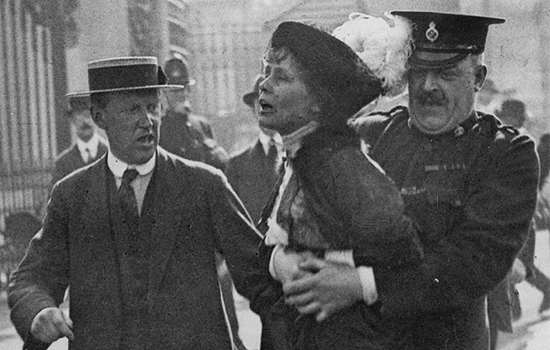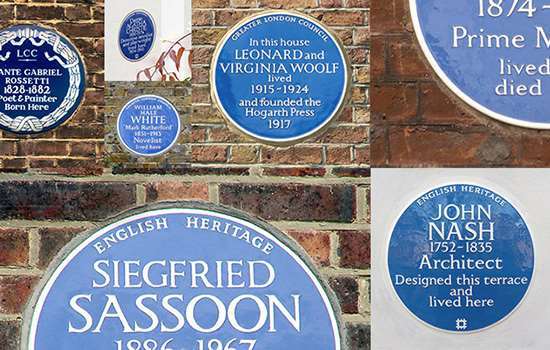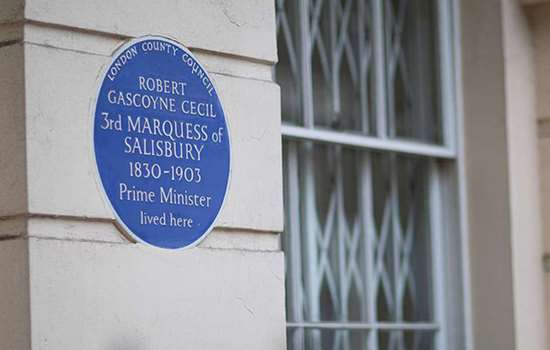WODEHOUSE, P.G. (1881-1975)
Plaque erected in 1988 by English Heritage at 17 Dunraven Street, Mayfair, London, W1K 7EG, City of Westminster
All images © English Heritage
Profession
Writer
Category
Literature
Inscription
P. G. WODEHOUSE 1881-1975 Writer lived here
Material
Ceramic
Pelham Grenville (‘Plum’) Wodehouse became Britain’s best-selling author in the 1920s, with the creation of his brilliantly crafted and superbly comic novels. A plaque at 17 Dunraven (formerly Norfolk) Street marks the grand Mayfair mansion where he lived between 1927 and 1934, at the height of his success.
Born in Guildford, Surrey, Wodehouse initially embarked on a career in banking, before turning to writing full time at the age of 20. His early successes included Mike (1909) – featuring Psmith (the ‘P’ being silent) – and Something Fresh (1915), the first of the Blandings Castle series.
In the 1920s, with the creation of his much-loved fictional characters Bertie Wooster and his manservant, Jeeves, Wodehouse became Britain’s best-selling author, with an unrivalled reputation as a humorist. The Jeeves and Wooster series finally came to an end with Aunts Aren’t Gentlemen in 1974.
Norfolk Street
Early in 1927 Wodehouse, his wife, Ethel, and stepdaughter, Leonora, moved to what was then 17 Norfolk Street, a palatial neo-Georgian terraced house designed by Sidney RJ Smith and built in 1897–8.
This was the height of Wodehouse’s success, and they were looked after by a retinue of 11 servants. The house was described by his nephew Patrick as ‘homely and warm, with a dotty Edwardian flavour just like the books Uncle Plum spent all his time writing’. Wodehouse himself called it ‘the gol-darnedest house you ever saw’.
During his time at number 17, Wodehouse wrote ten books, usually in his bedroom, which he found ‘really jolly’; these included Summer Lightning (1929), Very Good, Jeeves (1930) and Right Ho, Jeeves (1934). Of Wodehouse’s typical daily routine, Leonora wrote:
He writes in the afternoon, when he must on no account be disturbed. It is understood that he is thinking deep thoughts and planning great novels, but when all the smoke has cleared away it really means that he is either asleep or eating an apple and reading Edgar Wallace.
Wodehouse and his wife lived at the house, dividing their time between England and the US, until the summer of 1934, when they moved to France.
SECOND WORLD WAR AND AFTER
After 1940 Wodehouse’s life and standing were to change. While living in France, he was captured by the invading Germans, and was interned for nearly a year before he was taken to Berlin. From there he naively made a series of broadcasts to an American audience. This disastrous blunder led to Wodehouse being denounced as a traitor and Nazi propagandist – accusations now known to have been completely without basis – and he was permanently exiled from Britain.
Wodehouse spent the rest of his life in America. A knighthood in 1975 – shortly before he died, at the age of 93 – was the first major symbol of forgiveness. The unveiling of Wodehouse’s plaque in 1988 by Queen Elizabeth, The Queen Mother, could perhaps be seen as another. In her unveiling speech she summed up the timeless appeal of Wodehouse’s work:
Sir Pelham Wodehouse succeeded in the great ambition of so many novelists: not only has he brought new words and expressions into the English language but he has also created characters whose names have become household words – Jeeves and Bertie, Lord Emsworth and his prize pig, the Empress of Blandings, and even Aunt Agatha, to name but a few, live on as immortal characters.
Nevertheless I think that Wodehouse's greatest gift is that 50 or 60 years after many of his books were written they still make us all laugh, and I am sure that generations to come will continue to laugh at them just as much as we have done.
Read more about PG Wodehouse in the Oxford Dictionary of National Biography.
Nearby Blue Plaques
More About Blue Plaques



